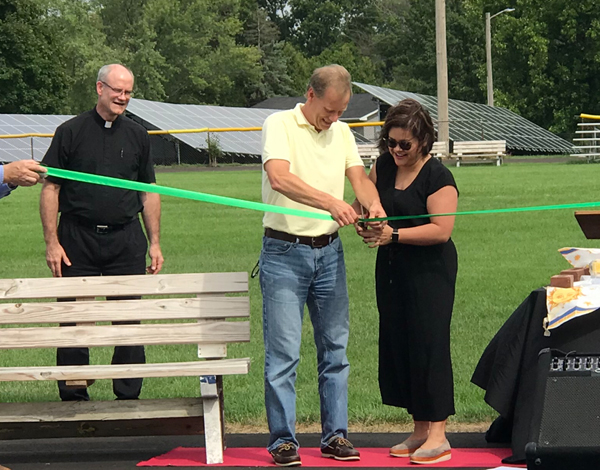For The Catholic Messenger
The new solar panels on Burlington Notre Dame’s campus should help the school save money on energy while reducing its carbon footprint.
“Pope Francis has called us to be good stewards of creation,” said Father Marty Goetz, pastor of Divine Mercy Parish in Burlington/West Burlington. “One of the ways we are doing that at Notre Dame is through our solar energy strategy. I also hope it helps our students grow in knowledge about science, being good stewards of the earth entrusted to us, and teamwork.”

School Board President Mark Knudson and past president Francesca To cut the “green” ribbon during the ribbon-cutting ceremony celebrating the new solar addition and clean energy at Notre Dame Schools in Burlington. Looking on is Father Dan Dorau, parochial vicar of Divine Mercy Parish-Burlington/West Burlington.
Precision Energy Services of Burlington recently proposed to Principal Bill Maupin the idea of installing 836 solar panels on the east side of the school’s soccer complex. According to the company, the photovoltaic system will harvest energy from the sun, creating enough electricity estimated to offset nearly 95 percent of the school’s power consumption. This should save the school money on electric bills for the next 30 years.
“When Precision Energy first approached us, we were definitely interested,” Maupin said. “Once we further researched the significant utility savings and the long-term benefits to our school and the environment, solar became an easy choice.”
To avoid upfront costs associated with installing the solar panels, Notre Dame took advantage of a Power Purchase Agreement (PPA). Precision Energy and Red Lion Renewables of Norwalk, Iowa, connected Notre Dame with a private Limited Liability Company (LLC) which can take advantage of state and federal tax programs not available to nonprofits such as Notre Dame.
John Fruehling, owner of Precision Energy Services, explained, “We design, install, operate and maintain the system, while the school agrees to site the panels on their campus. Notre Dame then purchases the system’s electric output from the LLC instead of from Alliant (an electric and natural gas utility service). Most schools are nonprofit institutions, so they are unable to take advantage of solar tax breaks. As a result, the majority of school installations tend to use PPA options to finance their renewable systems. This financial arrangement allows Notre Dame to receive long-term, low-cost electricity while the LLC is able to capture financial incentives like the tax credits and depreciation benefits.”
Brian Fleming, Precision Energy’s business development director, added, “The amount of sunlight that strikes the earth’s surface in just one hour delivers enough free energy to power the world economy for an entire year. It obviously made good financial sense for Notre Dame to responsibly benefit from this abundant natural resource.”
After the school board endorsed the project, Notre Dame’s business office and the Diocese of Davenport conducted due diligence before granting approval. “We wanted to be absolutely confident that a project of this size and scope was viewed and evaluated from all perspectives and by all appropriate governing parties before moving forward,” said Deb Trine, Notre Dame’s business manager.
Maupin cited several other cost-cutting, energy-saving measures that have been taken at the school recently in addition to the new solar arrays. “This system will produce almost 95 percent of our electricity for the next 25-30 years. By recently installing LED lighting and reducing our overall power consumption, the dollars saved on our energy costs will be used to help pay for teacher salaries, computers and other capital improvements.” Notre Dame currently allocates more than 85 percent of its annual budget towards teacher compensation.
The solar panels also present an educational opportunity for students and other members of the school community. Maupin said students will be able to monitor daily energy production from their Chromebooks and also have the opportunity to learn the science and financial aspects involved with harvesting solar energy.
“By monitoring daily production of the panels from their classrooms, our students will learn more about solar energy and the advantages of using alternate forms of energy. The business model applied and the long-term savings will be valuable teaching tools for kids to actively observe from a financial perspective.”











